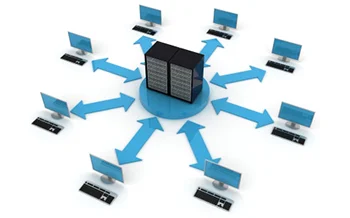SMB & Backup and Disaster Recovery (BDR)
Backup and Disaster Recovery (BDR) is the process of identifying, planning, implementing, testing, and maintaining an effective disaster recovery strategy for small businesses within a specific industry. The goal of BDR is to ensure that if a disaster does strike your company you will be able to recover without regional or national interruption.
In today's society, every small business is automatically part of the Internet community. Small business benefit from access to a worldwide workforce and can quickly integrate with other businesses quickly. However, this multi-national accessibility has presented small businesses with new challenges in protecting the critical applications that keep them up and running.
BDR is a solution to this problem. It provides small businesses with a plan for recovering their services in the event of a disaster.
To implement an effective BDR solution, you must first assess your existing IT infrastructure and network to assess your risks and vulnerabilities. You must then develop a BDR strategy that will be responsive to these risks and vulnerabilities, while at the same time maintaining both an operational budget and critical business continuity priorities.
Disaster Recovery Plans: Do You Have One?
Disaster Recovery Plans: Do You Have One?
Disaster recovery and business continuity plans are issues that almost all small businesses fail to think about. More frequently, they decide they haven’t the resources to address such “unthinkables.”
If your business was down for 1-2 days or more, what costs would you incur?
Lost revenues and lost productivity. These are obvious. You won’t make the money that you would have if you remained open. This is especially true if you provide a service. Services are inherently tied to time, and time cannot be re-created. Sure, you can work extra hours next week, but it won’t be a service provided at the time it was expected. However, even if you provide a product that can be purchased next week instead of today, a customer didn’t get it when they most wanted or needed it.
There are other far more serious consequences of business downtime than just unsold goods and services. There are the intangibles that can’t be so easily measured but have long-term consequences. For example
Helping the competition – You give your competition a real edge. Present clients and potential ones may go to a competitor while you are down. Not all will return. Your competitors now have ammunition against you to use in sales pitches.
Employee frustration – Employees will carry the burden of the extra hours and stress of helping get things back together. That can lead to a lot of frustration, which if things don’t get back to normal quickly, can damage long-term productivity. Most importantly, it can damage the respect they have for management (that means you). In general, they will recognize that you didn’t have the foresight and wisdom to anticipate the need to create disaster recovery and continuity plans. How can that not damage their trust and support for the company and you?
Negative brand reputation –Your customers will also wonder how you couldn’t have cared enough to make plans to handle trouble. Think of the negative way a customer sees it. The event suggests a company that doesn’t think ahead. A client is not “off base” to feel angry that you didnt care enough to make plans to support him if a disaster hit. Also, if you can’t handle disasters well, what else aren’t you handling properly?
These are just a few of the reasons everyone needs to consider disaster recovery. To learn more, see our e-guide “Staying Alive: The Definitive Guide to Business Continuity and Disaster Recovery for Small Businesses“.
8 Cold Hard Truths for SMBs Not Worried About Disaster Recovery and Business Continuity
The foundation of any successful business continuity solution is the ability to retrieve data from any point in time from anywhere. When the topic of data recovery and business continuity comes up, you get the feeling that many decision makers at smaller businesses and organizations wish they could channel their inner six year old, simply cover their ears, and sing "La, la, la. I Can't Hear You. I'm Not Listening."
Everybody thinks bad things only happen to other people. Just because we hear about a fatal car accident on the morning news, doesn't mean we fixate on that news when we ourselves get into a car and drive to work.
So no matter how many times the owner or executive of a small to midsize business (SMB) hears of other small businesses being crippled by hurricanes, tornados, fires, or flooding, they aren't necessarily overcome with fear to the point that they feel an urgency to take action.
Sure, they may think about backup and data recovery solutions a little more that day, but not enough to initiate immediate change or reverse a lenient approach to their processes.
If you fall into this category, here are eight cold hard truths to consider
- It isn't natural disasters or catastrophic losses like fires that take down small businesses but something far more sinister – malware. Cyber attacks through malware have grown exponentially in the past four years. Malware is hitting everything from PCs to Macs to mobile devices and it's inflicting damage.
- Over half of the small businesses in the U.S. have experienced disruptions in day-to-day business operations. 81% of these incidents have led to downtime that has lasted anywhere from one to three days.
- According to data compiled by the Hughes Marketing Group, 90% of companies employing less than 100 people spend fewer than eight hours a month on their business continuity plan.
- 80% of businesses that have experienced a major disaster are out of business within three years. Meanwhile, 40% of businesses impacted by critical IT failure cease operations within one year. 44% of businesses ravaged by a fire fail to ever reopen, and only 33% of those that do reopen survive any longer than three years.
- Disaster recovery solution providers estimate that 60% to 70% of all business disruptions originate internally – most likely due to hardware or software failure or human error.
- 93% of businesses unable to access their data center for ten or more days filed for bankruptcy within twelve months of the incident.
- In the United States alone, there are over 140,000 hard drive crashes each week.
- 34% of SMBs never test their backup and recovery solutions – of those who do, over 75% found holes and failures in their strategies.
It's critical that small businesses review their backup and disaster recovery processes and take business continuity seriously. Given the vulnerabilities associated with the cloud and workforce mobility, the risk of critical data loss today is quite serious and firms must be truly prepared for the unexpected.
Data Loss Can Cause You to Shut Down
Small and medium sized businesses today are relying more than ever on IT systems to efficiently run their business, support customers and optimize productivity. These systems house sensitive digital data ranging from employee and customer information, to internal emails, documents and financial records, sales orders and transaction histories. This is in addition to applications and programs critical to daily business functions and customer service.
While corporate-level data losses and insider theft are well publicized, many smaller businesses have also become casualties of data loss and theft. Following a significant data loss, it is estimated that a small-to-medium sized business can lose up to 25% in daily revenue by the end of the first week. Projected lost daily revenue increases to 40% one month into a major data loss.
According to The National Archives & Records Administration in Washington, 93% of companies that have experienced data loss, coupled with prolonged downtime for ten or more days, have filed for bankruptcy within twelve months of the incident while 50% wasted no time and filed for bankruptcy immediately. Finally, 43% of companies with no data recovery and business continuity plan actually go out of business following a major data loss.
Still, a survey conducted by Symantec SMB revealed that fewer than half of SMBs surveyed backup their data each week. Only 23% of those surveyed said they backup data every day and have a business continuity plan in place.
Businesses play on a much bigger playing field than they did two decades ago. Any disruptive technological event – even the smallest of incidents – can have an amplified impact on day-to-day business and profitability. Being proactive with data recovery solutions, and having emergency response procedures in place prior to a disruption or data disaster, is the only way to minimize downtime and soften the impact of such events.
Five Things You Should Do Right Now to Preserve Your Network and Systems
As catastrophic as data loss is, the number of businesses that still are not backing up their network is unbelievable. According to the Symantec Small to Medium Size Businesses (SMB) data, only 23% of SMBs are backing up their data on a daily basis and fewer than 50% are backing up data weekly.
1. Backup Files Every Day – As catastrophic as data loss is, the number of businesses that still are not backing up their network is unbelievable. According to the Symantec Small to Medium Size Businesses (SMB) data, only 23% of SMBs are backing up their data on a daily basis and fewer than 50% are backing up data weekly. Any number of events can result in data loss, so the importance of frequently backing up your network cannot be overstated.
2. Ensure Backup Procedures Are Checked Regularly – Many times business owners think that they have a backup system in place only to find out after it’s too late that it hasn’t been working properly. It may seem like your files are being backed up daily, however, the backup could have become corrupt or it is not backing up huge chunks of critical data. Check your backup procedures regularly to ensure they are working properly in order to be sure that ALL of your data can be recovered. In the age of BYOD (Bring-Your-Own-Devices) it is also important to frequently backup data on your employee’s personal laptops, iPads or Blackberrys, so make sure you have a procedure in place to check those backups as well.
3. Make Sure Updated Virus Protection and Firewalls Are Always Enabled – Far too many companies either have no virus protection, expired virus software licenses, or disabled virus programs that aren’t running at all. This makes their business technology vulnerable to virus attacks from emails, spam, data downloads, and unreputable websites. Further, because of inadequate firewall protection about 40% of small to medium businesses will have their network accessed by a hacker. Chances are, when these businesses are attacked they will be entirely unaware it is happening. In order to protect your valuable data and assets, ensure your virus protection is adequate, up-to-date and functioning properly and that your firewall is intact. Finally, don’t forget to update security patches and change passwords when an employee leaves in order to deter hacking attempts.
4. Monitor Server Drives – Dangerously full server drives can bring their own set of problems – ranging from program and server crashes to sluggish email delivery. Proactive monitoring and maintenance of your server can spare your business a lot of problems down the road.
5. Regularly Check Critical Built-In Logs – Very few problems with technology emerge suddenly. These problems typically progress over time and evolve into more serious problems. Frequently review your critical built-in log files to help identify the problem before it has gotten out of control and wreaks havoc on your business infrastructure.









